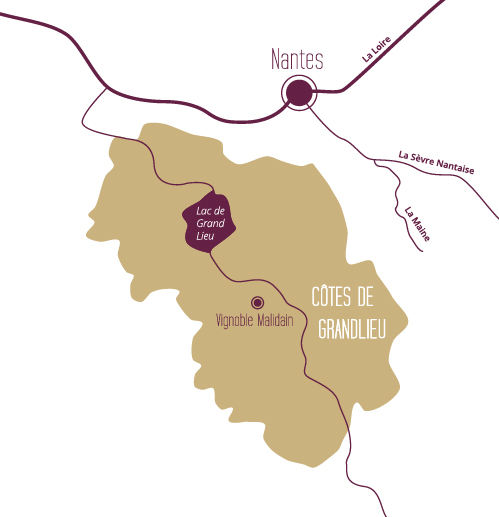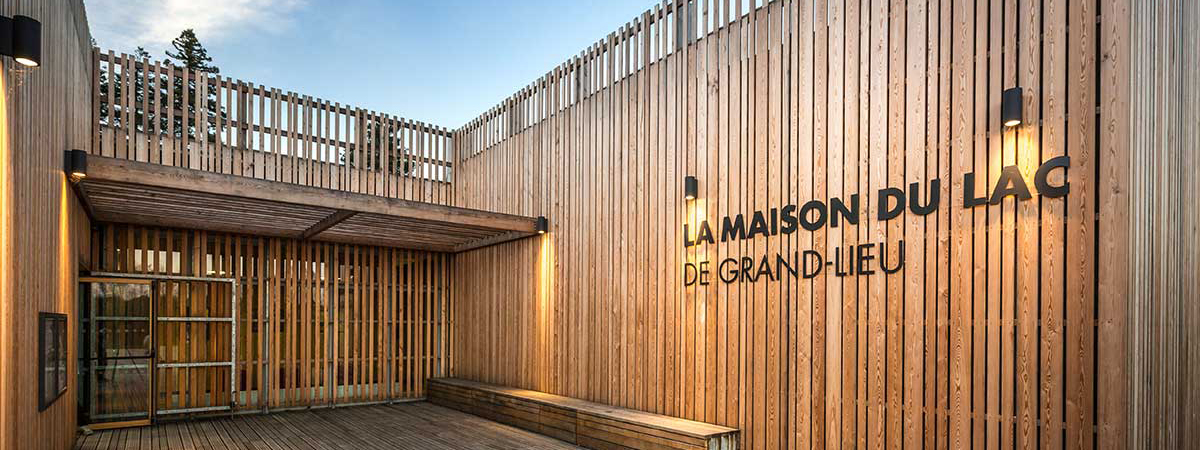SIGNIFICATION DE L’APPELLATION

Dernière-née des appellations d’origine sous-régionales de Muscadet en 1994, c’est la plus occidentale et la plus proche de l’océan Atlantique.
Le petit vignoble d’à peine 300 hectares de l’AOP Muscadet Côtes de Grandlieu s’étend au sud-ouest de Nantes sur dix-neuf communes à la périphérie du lac de Grandlieu, en Loire-Atlantique et en Vendée. Grâce à cette proximité de 9000 hectares des eaux du lac, elle bénéficie d’un micro-climat qui favorise la précocité du cépage Melon B.
Les sols de sables et de galets, issus de roches métamorphiques tels que gneiss et micaschistes, donnent naissance à des vins secs alliant finesse et fraîcheur.
L’élaboration sur lie, majoritaire, renforce la fraîcheur, le fruité et la complexité des vins.
Les Côtes de Grandlieu se différencient par une délimitation parcellaire et sur des vignes adultes de plus de 7 ans, ce qui apporte inévitablement un plus qualitatif.
LE LAC DE GRANDLIEU
Le lac de Grand-Lieu est un lac situé dans le département de la Loire-Atlantique, au sud-ouest de Nantes, ainsi qu’à une dizaine de kilomètres au sud de la Loire, il s’étend en quasi-totalité sur le territoire de la commune de Saint-Philbert-de-Grand-Lieu.
Il s’agit en hiver du plus grand lac naturel de plaine français.
La faune et la flore du lac sont remarquables, et c’est à ce titre qu’il est classé comme réserve naturelle nationale pour sa plus grande partie (2 694,60 hectares) et réserve naturelle régionale pour sa partie orientale (soit 655,79 hectares). Ce sont 270 espèces d’oiseaux, 19 espèces de reptiles et batraciens, 30 espèces de poissons et une cinquantaine de mammifères qui peuplent le site. C’est notamment un milieu très favorable pour l’anguille d’Europe. La zone du lac abrite 250 espèces de végétaux et 220 d’algues. Huit plantes s’y trouvant sont protégées au niveau international. La majeure partie du lac est recouverte d’herbiers flottants. Il a été classé en 1995 comme zone humide d’importance internationale par la convention de Ramsar.
Le lac de Grand-Lieu est à la fois vaste et très peu profond (1,60 m de profondeur moyenne en été, environ 4 m en hiver), ce qui explique ses spécificités écologiques. Il occupe une cuvette de faible profondeur et aux bords de faible dénivelé. Pour cette raison, les contours du lac sont particulièrement changeants. Quant à sa superficie, elle varie du simple au double au cours d’une année, passant d’environ 35 km2 en été à 65 km2en hiver.
Environ 25 km2, principalement dans sa partie est, sont formés par un cœur d’eaux plus vives. Au-delà, le lac est composé de forêts flottantes dites levis, de marais et de prairies inondables, recouverts ou non selon la saison.
La superficie en eaux libres atteint son maximum (environ 2 200 hectares) en hiver, lorsque les herbiers flottants disparaissent. La zone s’est accrue de près de 13 hectares en dix ans, diminuant d’autant la surface des roselières. C’est dans les eaux libres qu’exercent les pêcheurs professionnels. Au centre du lac, le potamot nageant parsème les eaux libres.
LA MAISON DU LAC DE GRANDLIEU
A Bouaye, à deux pas du Lac, La Maison du Lac de Grand-Lieu permet de découvrir Le Lac de Grandlieu et toute sa richesse biologique.
Elle propose des visites et une exposition, qui présente la richesse des paysages et du patrimoine naturel et historique du lac de Grand-Lieu à travers une scénographie ludique ponctuée d’installations multimédias. Une balade mène ensuite à l’ancien Pavillon de chasse du parfumeur Guerlain et son point de vue sur le lac, le voyage devient alors fantastique et poétique. Pour parfaire cette visite pendant la période estivale, sur la terrasse de cette magnifique demeure, des accords mets locaux et vins (de l’appellation Côtes de Grandlieu !) sont proposés aux visiteurs.
